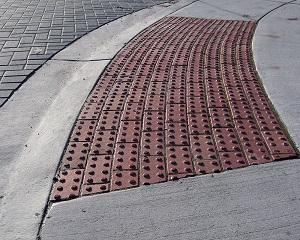Pavement
Contents |
[edit] Introduction
Pavements are a form of exterior surface covering, typically raised and used by pedestrians, running parallel to, and on either side of a road. They provide an area that is separated from, and so protected from vehicular traffic. However, the term can also be used to refer to other paved areas, such as pedestrianised streets, patios, courtyards, driveways, and so on.
Pavements can be constructed using asphalt, concrete, flagstone, cobblestone, artificial stone, bricks, tiles and timber.
The term ‘paver’ or ‘paviour’ (pavior in the USA) refers to a paving stone, tile, brick or piece of concrete used to form a pavement surface. They are usually laid to a fall of 1:60 or more to drain water to one or both sides. They are usually built to a minimum width of 1.2 m where this is possible.
The main British and European Manufacturing Standards relating to paving are:
[edit] Types of pavement
[edit] Flexible paving
This may consist of the following layers:
- 100 mm blinded and consolidated hardcore.
- 40 mm thick base course of coated macadam.
- 20 mm thick wearing course of coated macadam.
[edit] Rigid paving
This may consist of the following layers:
- 75 mm thick consolidated hardcore.
- 75 mm thick plain insitu concrete with contraction and expansion joints.
[edit] Pavers
This may consist of the following layers:
- 75 mm thick consolidated hardcore.
- 25 mm thick dry cement/sand bed.
- 600 x 600 x 50 mm precast concrete pavers laid with butt joints filled with mortar.
[edit] Small unit pavers
This may consist of the following layers:
- 100 mm thick consolidated hardcore.
- 50 mm thick bed of sharp sand.
- 60 mm thick precast concrete plain or interlocking pavers vibrated into bed with sand-filled joints.
[edit] Cobblestones
Cobblestone were frequently used in early pavement construction. They are small stones or pebbles that were traditionally gathered from stream beds and hence had been rounded and smoothed by water. They are usually set in sand or bound together with mortar.
[edit] Setts
Setts are rectangular stones, usually made of granite, often used in landscape architecture as they can be arranged in various decorative ways with different patterns and colours.
The second edition of The Dictionary of Urbanism by Rob Cowan, published in 2020, suggests that a sett is: ‘A small rectangular quarried stone used for paving. Setts are often popularily called cobbles (see cobbled). Wooden and rubber setts have also occasionally been used.'
A Belgian block is: ‘A cubical paving block; a sett’
[edit] Interlocking grids
These are concrete or stone units with open, permeable spaces between them.
[edit] Tactile paving
These come in a variety of forms and are commonly used in urban areas as a means of hazard warning for visually-impaired pedestrians at kerb edges, road crossings and gradient changes. They can also be used on cycle paths as a way of demarcating the area to be used by cyclists.
For more information, see Hazard warning surfaces.
[edit] Green paving
New products are being developed that incorporate technology with to make pavements smarter and greener. For example, see Pavegen.
[edit] Other definitions
The second edition of The Dictionary of Urbanism by Rob Cowan, published in 2020, suggests that pavement can mean:
- '(UK) The raised surface for pedestrians beside a street or road. The US equivalent is sidewalk, though pavement is used in some parts of the southern states.
- (US, and UK highway engineers) The structure of a road, including its surface and underlying foundations. The general UK equivalent is roadway.
- A paved surface.
- An alley.
From the Latin pavire, to beat hard.'
[edit] Related articles on Designing Buildings
- Binder course.
- Bitumen binder may delay road surface deterioration.
- Bituminous mixing and laying plant.
- BREEAM Hard landscaping and boundary protection.
- Britain's historic paving.
- Capping layer.
- Coal holes, pavement lights, kerbs and utilities and wood-block paving.
- Code of Practice for Ironwork Systems Installation and Refurbishment.
- Glossary of paving terms.
- Groundwater control in urban areas.
- Hazard warning surfaces.
- Highway drainage.
- Hoggin.
- How to lay block paving.
- Kerbs.
- Landscape design.
- Overview of the road development process.
- Pavegen.
- Pedestrianised.
- Permeable pavements.
- Pervious pavement.
- Road construction.
- Types of road and street.
- Vicars' close.
- Walkway.
[edit] External references
- ‘Building Construction Handbook’ (6th ed.), CHUDLEY, R., GREENO, R., Butterworth-Heinemann (2007)
Featured articles and news
Moisture, fire safety and emerging trends in living walls
How wet is your wall?
Current policy explained and newly published consultation by the UK and Welsh Governments.
British architecture 1919–39. Book review.
Conservation of listed prefabs in Moseley.
Energy industry calls for urgent reform.
Heritage staff wellbeing at work survey.
A five minute introduction.
50th Golden anniversary ECA Edmundson apprentice award
Showcasing the very best electrotechnical and engineering services for half a century.
Welsh government consults on HRBs and reg changes
Seeking feedback on a new regulatory regime and a broad range of issues.
CIOB Client Guide (2nd edition) March 2025
Free download covering statutory dutyholder roles under the Building Safety Act and much more.
AI and automation in 3D modelling and spatial design
Can almost half of design development tasks be automated?
Minister quizzed, as responsibility transfers to MHCLG and BSR publishes new building control guidance.
UK environmental regulations reform 2025
Amid wider new approaches to ensure regulators and regulation support growth.
The maintenance challenge of tenements.
BSRIA Statutory Compliance Inspection Checklist
BG80/2025 now significantly updated to include requirements related to important changes in legislation.
Shortlist for the 2025 Roofscape Design Awards
Talent and innovation showcase announcement from the trussed rafter industry.




























